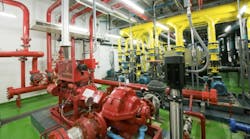Stable demand and slowly improving business conditions characterized the manufacturing economy for much of the summer, and supply chain companies—especially distributors—are cautiously optimistic that those conditions will hold.
In particular, distributors report some strength in industrial equipment, which fuels many of the manufacturing sectors they serve. Brian Ellison, president of America II Electronics, points to growth in the distributor’s instrumentation and control business as a key example.
Florida-based America II sells a wide range of electronic components, specializing in obsolete and end-of-life parts; the company focuses its instrumentation and control business on mining, automotive, semiconductor and similar manufacturing industries. Ellison says buying activity in the sector has picked up over the past quarter, in particular.
“There was a lot of conservative buying in the 18 months prior to this past quarter,” he explains. “Now we’re seeing lead time orders from customers in that segment.”
Ellison’s observations are in line with what other industry reports. The Institute for Supply Management’s Purchasing Manager’s Index showed three straight months of growth in manufacturing over the summer, for instance, with June, July and August heading back into expansion mode following contraction in May. The PMI, a key economic indicator, averaged 52 in the 12 months ending August 31, above the 50-point mark indicating growth in manufacturing.
Allied Electronics’ Mark Simon says he’s seeing some effects of the slow and steady improvement as well, particularly in the West, where business had been lagging. He points to medical and high-tech manufacturing in particular, adding that Allied is fielding more sales inquiries from semiconductor manufacturers recently, a hopeful harbinger of business to come. Tool makers in the extreme Northwest were looking like another source of potential strength over the summer, he adds. Simon pointed to dwindling customer inventory—the PMI’s Inventory Index fell for the second straight month in August, for instance—as a key factor for high-service distributors such as Allied, across all markets.
“Overall, customer inventory is down,” says Simon, Allied’s vice president of sales. “We’re a high-service distributor with hundreds of millions of dollars in inventory, so that’s good for us.”
Diversity is also good for Allied, which sells electronic components and electromechanical products to all segments of the industrial economy. Machinery and equipment crosses many of those, and Allied supports the sector in a variety of ways, selling to makers of industrial equipment as well as to users of the equipment on the factory floor. Allied sells to OEMs in the sector, and also supports machinery and equipment maintenance with its lines of test equipment and automation and control products.
Though he says the West is looking up—and that medical manufacturers are doing well everywhere—Simon also points to some trouble spots on the industrial horizon. He says makers of agricultural equipment are slowing down, the mining industry has not been good, and that energy markets in the Southwest are spotty at best. Looking at energy in particular, Simon points to a decline that began a year ago but continues to be marked by some bright spots among makers of ancillary products for energy markets.
Sequestration—the series of automatic government budget cuts that began in March—is another ongoing source of concern.
“It’s real,” says Simon, pointing to the cuts that continue to threaten projects and programs nationwide. “There are customers that remind us of it all the time. They’re worried about it. They may still be busy with previously contracted work, but it’s not clear what will happen down the road.
“It’s a continuous source of worry and concern [for many customers]. And that’s a big part of our business as well.”
Supply chain companies have warned of a trickle-down effect of sequestration, as many businesses that support government and military projects face potential losses due to budget shortfalls.










